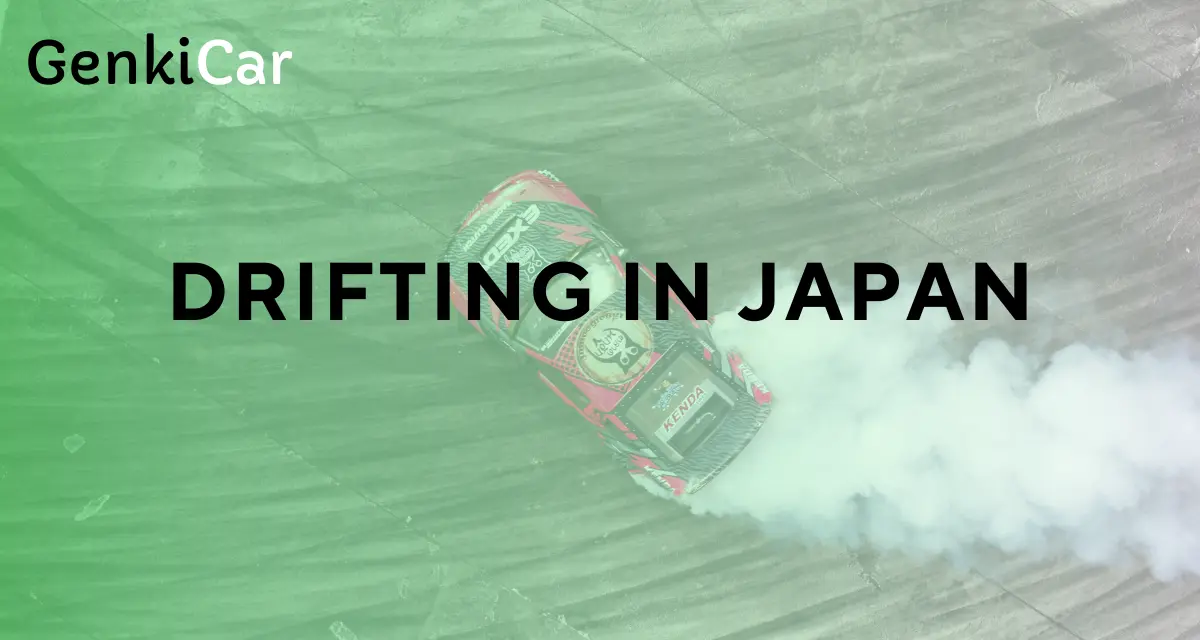Significant progress was put in reducing the numbers of car accidents in Japan over the past decade, but recent data shows a concerning reversal. Between 2013 and 2022, the country consistently saw a decline in both accidents and fatalities, reaching a record low of 2,610 deaths in 2022. However, in 2023, traffic-related fatalities rose for the first time in eight years, totaling 2,678 deaths. This uptick suggests new challenges in road safety, including an aging driver population and increased distractions from mobile devices.
The total number of car accidents in Japan also followed a downward trend, decreasing from over 600,000 incidents in 2013 to approximately 307,911 in 2023. This drop is largely due to stricter traffic laws, improved vehicle safety features, and national awareness campaigns. However, the 7,072 increase in accidents from 2022 to 2023 indicates that Japan may need to reinforce road safety initiatives to prevent further setbacks.
Fatalities and Injuries Breakdown
In 2023, Japan recorded 2,678 traffic-related deaths, a slight but significant increase from the previous year. Injuries also rose to 365,027 cases, reflecting a 8,426 increase compared to 2022.
One of the most alarming trends is the high fatality rate among elderly individuals. In 2023, 54.7% of all traffic deaths involved people aged 65 and older, highlighting the growing safety concerns for senior drivers and pedestrians. This demographic remains the most vulnerable, often involved in collisions due to slower reaction times and misjudgment in traffic situations.
Pedestrians and cyclists are also among the most affected. Nearly 40% of all fatalities in 2023 were non-motorists, with many incidents occurring at intersections and crosswalks. The rise in pedestrian deaths emphasizes the need for enhanced road safety measures, particularly in urban areas where foot traffic is high.
Regional Differences in Car Accidents in Japan
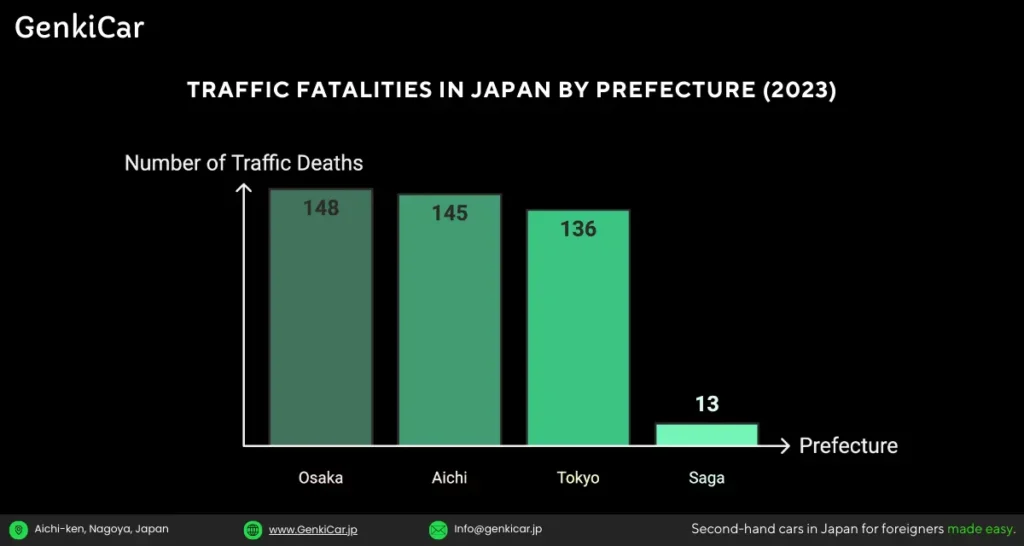
Traffic accident trends vary widely across Japan, with some prefectures consistently reporting higher fatality rates than others. In 2023, Osaka recorded the highest number of traffic deaths (148), followed by Aichi (145) and Tokyo (136). These urban centers have dense road networks and heavy traffic congestion, increasing the likelihood of serious accidents.
On the other end of the spectrum, Saga Prefecture reported the lowest fatalities, with only 13 deaths. Additionally, when comparing accident rates per 100,000 people, Tokushima (3.98), Mie (3.79), and Aomori (3.74) had the highest fatality averages, while Tokyo had the lowest rate (0.977). This suggests that while Tokyo experiences a high volume of accidents, its safety infrastructure and strict enforcement contribute to lower per-capita fatalities.
The disparity in accident rates across regions highlights the importance of location-specific safety strategies. While urban areas struggle with traffic congestion and pedestrian-related car accidents in Japan, rural regions face challenges like bad road conditions, lower visibility, and higher speeds. Checking these risks is crucial for reducing traffic fatalities across Japan.
Start your journey toward car ownership in Japan! Fill out our form, and we’ll connect you with a dealership that speaks your language and can guide you through every step.
Why Are Car Accidents in Japan Increasing?
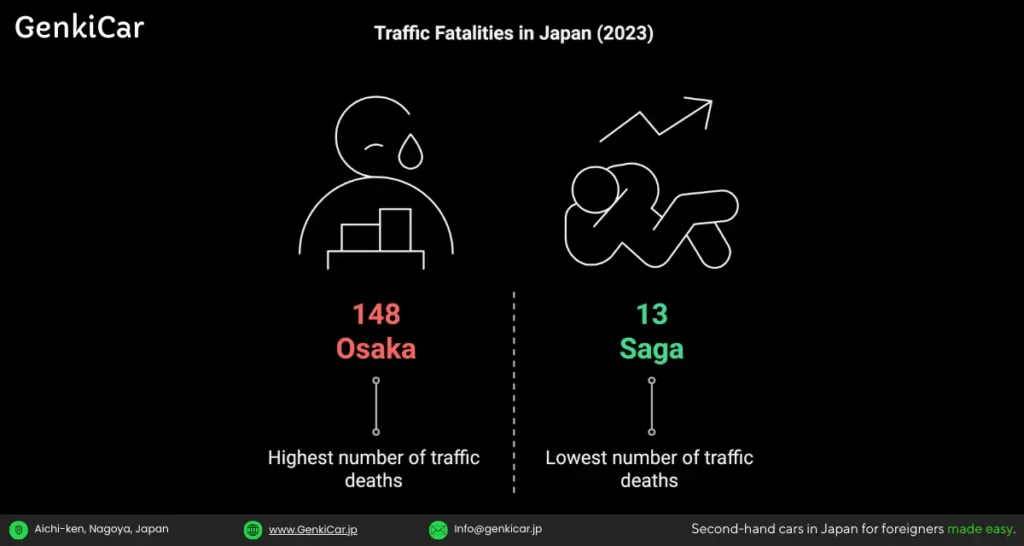
One of the leading causes of the recent rise in car accidents in Japan is distracted driving, particularly due to smartphone use. Despite strict laws prohibiting the use of mobile phones while driving, many drivers continue to engage in activities such as texting, checking navigation apps, or even browsing social media. The penalty for using a smartphone while driving was significantly increased in 2019, yet enforcement remains a challenge.
According to police reports, more than 20% of car accidents in Japan in urban areas are linked to driver distraction, with smartphone use being a primary factor. Even momentary inattention, such as looking at a notification, can lead to rear-end collisions, lane deviations, or failure to notice pedestrians at crosswalks. To combat this issue, Japan has increased awareness campaigns and encourages the use of hands-free technology and in-car AI assistants.
Elderly Drivers and Road Safety Challenges
Japan has one of the world’s oldest populations, and this demographic shift has had a noticeable impact on road safety. In 2023, over 54.7% of traffic fatalities involved drivers or pedestrians aged 65 and older, underscoring the risks associated with aging drivers. Slower reaction times, decreased vision, and cognitive decline contribute to misjudging distances, pressing the wrong pedal, or failing to stop at intersections.
Weather and Road Conditions
Japan’s diverse climate and seasonal weather conditions also contribute to car accidents. Heavy snowfall in northern regions, such as Hokkaido and Tohoku, leads to slippery roads, reduced visibility, and an increased risk of skidding. In winter, car accidents in Japan due to black ice and snow buildup are among the highest causes of fatalities.
Meanwhile, typhoons and heavy rainfall during Japan’s rainy season (June–July) result in hydroplaning and road surface damage, leading to poor braking efficiency and higher collision risks. Additionally, foggy conditions in mountainous areas reduce visibility, making driving hazardous.
Urban vs. Rural Accident Rates
Traffic accident trends vary significantly between urban and rural areas in Japan. Cities like Tokyo, Osaka, and Nagoya have higher accident frequencies due to dense traffic, complex intersections, and a high number of pedestrians and cyclists. However, these urban areas generally have lower fatality rates due to strict traffic enforcement, speed limits, and advanced road safety infrastructure such as pedestrian overpasses and automated traffic control systems.
In contrast, rural prefectures such as Aomori, Mie, and Tokushima report higher fatality rates per capita. This is due to factors like:
- Higher speed limits and less traffic congestion, leading to more severe collisions.
- Fewer streetlights and road safety measures, increasing the risk of night-time accidents.
- Longer emergency response times, as rural areas have fewer medical facilities nearby.
What Are the Most Common Causes of Car Accidents in Japan?
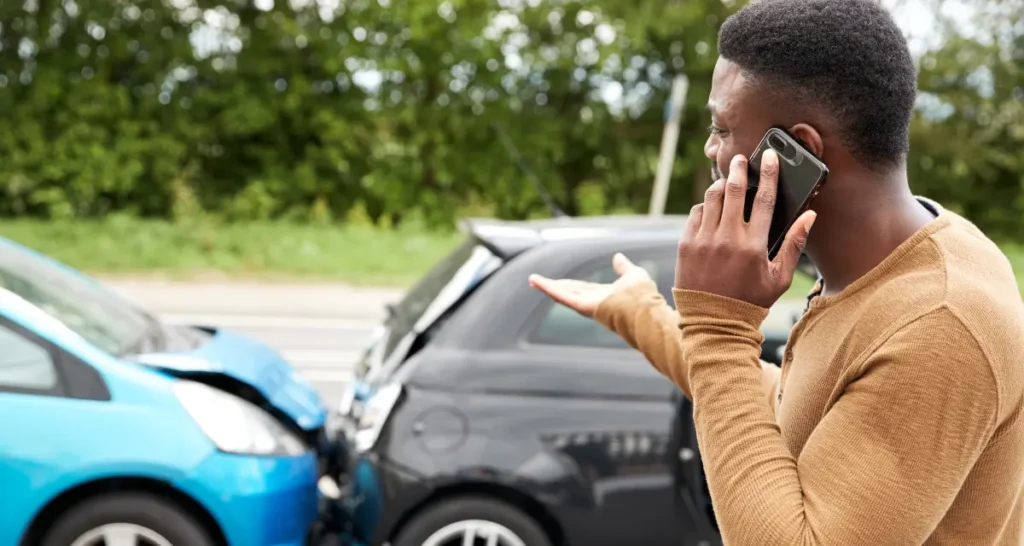
Speeding remains a significant factor in many car accidents Japan, particularly on expressways and rural roads where drivers may feel less restricted. While Japan has strict speed limits typically 100 km/h on expressways and 40–60 km/h on city roads, many drivers exceed these limits, especially late at night or in areas with low traffic enforcement.
Reckless driving behaviors, such as tailgating, aggressive lane changes, and sudden braking, also contribute to severe car accidents in Japan. Police reports indicate that excessive speed is a leading factor in fatal crashes, as it reduces reaction time and increases impact severity. Recently, Japan has implemented automated speed enforcement cameras, and penalties for dangerous driving have been strengthened under the 2020 Road Traffic Law amendments.
Drunk Driving Laws and Enforcement
Japan has one of the strictest zero-tolerance policies on drunk driving in the world. Even a blood alcohol concentration (BAC) as low as 0.03% (well below the U.S. and European standards) is punishable by law. The consequences for driving under the influence (DUI) include:
- Up to five years in prison or a fine of up to 1 million yen.
- License revocation and a mandatory rehabilitation program.
- Employer liability, meaning passengers, car owners, and even bars serving alcohol to drivers may also face legal consequences.
Despite these harsh penalties, drunk driving still accounts for a small but deadly percentage of car accidents in Japan. In 2023, alcohol-related crashes resulted in over 150 fatalities, with most occurring late at night. To further deter DUI offenses, random breathalyzer tests and public awareness campaigns have been intensified.
Intersection and Pedestrian-Related Car Accidents in Japan
Intersections are among the most dangerous locations on Japanese roads, accounting for over 40% of all car accidents in Japan. Many collisions occur due to:
- Failure to yield to pedestrians at crosswalks.
- Running red lights or making unsafe turns.
- Limited visibility at narrow intersections, especially in older urban areas with tight roads.
Pedestrian-related accidents are particularly high in Tokyo, Osaka, and other major cities, where foot traffic is dense. Elderly pedestrians are the most vulnerable, often misjudging crossing times or struggling with oncoming vehicle speeds.
How does Japan compare to other countries in terms of road safety?
When it comes to road safety, Japan consistently ranks as one of the safest countries, boasting a lower traffic fatality rate compared to both the United States and many European nations. In 2023, Japan recorded 2,678 traffic deaths, translating to approximately 2.14 fatalities per 100,000 people. This is significantly lower than the U.S. where the rate was approximately 12.4 fatalities per 100,000 people in 2022, and also lower than the European Union’s average of 5 fatalities per 100,000 people.
While Japan’s overall road safety is impressive, its aging population and the recent uptick in accidents highlight the need for continued efforts to improve safety.
The U.S. and European countries face different challenges. In the U.S., drunk driving and speeding are significant contributors to accidents, while many European nations benefit from strong public transport systems that reduce individual car usage and the associated risk of accidents. Japan’s has a combination of high vehicle density and advanced road infrastructure gives it a relatively low accident rate despite these challenges.
Impact of Car Safety Technology
Japan uses advanced car safety technologies, which play a big role in its low accident rates. Such as collision avoidance systems, automatic emergency braking, lane-keeping assist, and adaptive cruise control are widely used in both new and used cars. These systems help mitigate human errors by assisting drivers in dangerous situations and preventing collisions before they happen.
In addition, Japan has introduced vehicle-to-everything (V2X) communication, which allows cars to interact with infrastructure (traffic lights, road signs) and other vehicles to improve traffic flow and reduce the risk of car accidents in Japan. Also, Japan has strict regulations that require car manufacturers to install certain safety features in all new vehicles, ensuring that the majority of cars on the road meet high safety standards.
Government Regulations and Driver Education
The Japanese government constantly trying to maintain high road safety standards through strict regulations and comprehensive driver education programs.
- Driver’s licenses in Japan are earned after passing a series of tests, including written exams, practical driving tests, and health evaluations. The process ensures that only qualified drivers are allowed on the road.
- Traffic law enforcement in Japan is rigorous, with frequent checks for speeding, drunk driving, and distracted driving. The use of traffic cameras and random DUI checkpoints further deters reckless driving.
- Japan also runs regular traffic safety campaigns to promote awareness, particularly targeting vulnerable road users like the elderly and pedestrians.
These efforts contribute to Japan’s impressive safety record but must adapt to evolving challenges, such as the growing number of elderly drivers and increased reliance on autonomous driving technologies.
In comparison, many countries face greater difficulties with driver education, inconsistent law enforcement, and lax regulations, leading to higher accident rates. However, as nations worldwide adopt more advanced technologies and stricter regulations, Japan’s leadership in road safety to be honest, remains a model for other countries to follow.
What Are the Best Ways to Prevent Car Accidents in Japan?

For foreigners driving in Japan, it is really important to understand local traffic laws and adjust driving behaviors accordingly to reduce the risk of accidents. Japan’s traffic rules can differ significantly from other countries, and failing to adhere to them can lead to accidents or fines.
Here are key safe driving practices for foreigners:
- Adhere to speed limits: Speeding is one of the most common causes of car accidents in Japan. Always pay attention to posted speed limits, which can change depending on the area, and avoid driving too fast, especially on unfamiliar roads.
- Drive on the left side of the road: Japan follows left-hand driving, meaning drivers should always keep to the left lane and yield to the right for overtaking vehicles.
- Use seat belts at all times: Japan has stringent seatbelt laws for all occupants of the vehicle, including rear passengers. Ensure that everyone in the car is buckled up, regardless of where they sit.
- Respect pedestrians: Pedestrian right-of-way is strictly enforced in Japan, and accidents involving pedestrians are common. Always yield at crosswalks and slow down when driving in busy areas.
- Avoid using your mobile phone: It is illegal to use a phone while driving unless using a hands-free device. Inattention caused by smartphone use has contributed to numerous accidents.
- Familiarize yourself with Japanese road signs: Some signs may be different from those in your home country. Learn to recognize key signals, including those indicating no-entry zones, parking restrictions, or warning of sudden curves. We have included the necessary signs in our traffic laws in Japan guide.
Foreign drivers must also have a valid International Driver’s Permit (IDP) in Japan, which allows them to drive legally for a short period. Many car rentals (if you are renting) will require this as part of their terms and conditions.
Practise Defensive Driving
Defensive driving is a proactive approach to driving that focuses on anticipating potential hazards, staying aware of surroundings, and making safe decisions to avoid car accidents in Japan. Especially, if you are crossing perfectures, road conditions can change quickly.
- Maintain a safe following distance: Always leave sufficient space between your vehicle and the one in front to allow for sudden stops or slowdowns..
- Be aware of blind spots: Japan’s narrow roads and tight intersections often make it difficult to see other vehicles. Always check your mirrors and look over your shoulder when changing lanes or turning.
- Avoid aggressive driving: Whether it’s tailgating, speeding, or erratically changing lanes, aggressive driving is not only dangerous but also increases the chance of accidents. Stay calm, patient, and focused at all times.
- Adapt to weather conditions: Always adjust your driving style to match weather conditions. In rainy or snowy weather, reduce your speed, maintain greater distance, and use fog lights when necessary.
Government Initiatives to Reduce Car Accidents in Japan
Japan’s aging population i would say is the main factor driving the country’s traffic safety efforts. With an increasing number of elderly drivers, there are growing concerns about car accidents in Japan caused by age-related issues such as slower reaction times, vision impairments, and cognitive decline. Japan has introduced stringent laws and innovative programs specifically designed to address elderly driver safety.
- Mandatory Health and Vision Tests: Drivers aged 70 and older must take regular health screenings and vision tests every three years to renew their driver’s license. Similar to Shaken. The tests assess physical and mental fitness to ensure that elderly individuals are still capable of safely operating a vehicle. If a driver fails the health screening, they are given the opportunity to undergo rehabilitation and may be required to take remedial driving lessons before their license is renewed.
- Rehabilitation and Education Programs: For elderly drivers who show signs of reduced ability, Japan has implemented driver rehabilitation courses aimed at improving skills and raising awareness of risks. The government also encourages elderly drivers to voluntarily surrender their license if they feel they are no longer able to drive safely.
- Innovative Safety Features for Elderly Drivers: To accommodate elderly drivers, the government has incentivized car manufacturers to produce vehicles with elderly-friendly features such as larger mirrors, easy-access seats, and automatic parking assistance.
Public Awareness Campaigns and Education
Public awareness is a cornerstone strategy to reduce car accidents in Japan. The government’s traffic safety campaigns and education programs target a wide range of road users, from young children to elderly pedestrians.
- Biannual Traffic Safety Weeks: Every spring and autumn, Japan runs nationwide Traffic Safety Campaign Weeks, during which local authorities, schools, and community organizations engage in educational activities. The Aim of campaigns focus on raising awareness of drunk driving, speeding, distracted driving, and the dangers posed to pedestrians, especially in urban areas. Public service announcements, workshops, and outreach events are organized to educate people on the importance of responsible driving.
- Driving Schools and Defensive Driving Courses: Japan places a strong emphasis on defensive driving education. All drivers, from young drivers to seniors, are encouraged to take defensive driving courses to better understand how to react to potential hazards. These courses teach drivers to anticipate risky situations and avoid making impulsive decisions. The focus is not only on technical skills but also on fostering an understanding of the human factors that lead to car accidents in Japan.
- Pedestrian Safety Education: Japan’s school programs educate children from an early age on pedestrian safety the importance of crossing at designated areas, looking both ways, and being cautious of vehicles. Public outreach programs also target elderly pedestrians, encouraging them to cross safely and avoid distractions like smartphones when on the road.
What to Do If You’re in a Car Accident in Japan?
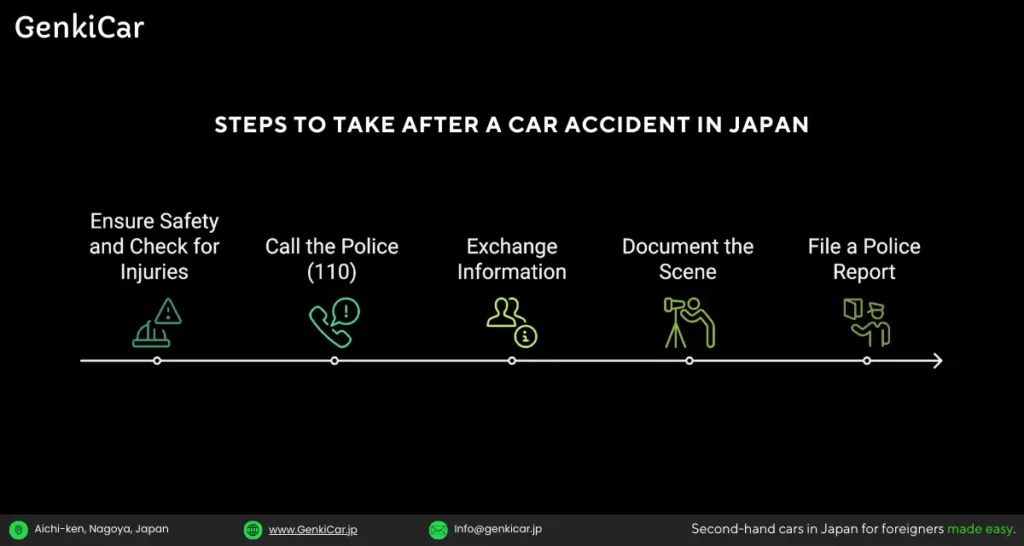
In the unfortunate event of a car accident in Japan, it’s crucial to stay calm and follow the proper legal procedures to ensure the situation is handled efficiently and safely. Here’s what we recommend you do:
- Ensure Safety and Check for Injuries: First, make sure everyone is safe and move vehicles, if possible, to a safe location. If anyone is injured, call for medical assistance immediately.
- Call the Police (110): In Japan, it’s mandatory to report all accidents to the police, regardless of the severity. Even tiny ones, dial 110 to inform authorities of the incident. The police will arrive at the scene to document the accident and provide official reports, which are vital for insurance claims and legal purposes.
- Exchange Information: Exchange your driver’s license, vehicle registration, and insurance details with the other parties involved. In addition, take note of the license plate numbers, the names and addresses of all parties, and any witnesses who may have seen the accident.
- Document the Scene: Take clear photographs of the accident scene, including damage to vehicles, injuries, road conditions, and any skid marks. These images will be crucial for insurance claims and legal processes.
- File a Police Report: If police do not arrive on the scene immediately, ensure that you file a police report at the nearest police station. This is especially important if the other party is uncooperative or there is a dispute over the accident’s cause.
Looking for a trusted dealership? Let us help! Get in touch for a list of top-rated, English-speaking dealers nearby.
Dealing with Insurance and Legal Procedures
Once you’ve completed the initial steps after the accident, dealing with insurance and legal procedures is the next crucial phase. Here’s how to proceed:
- Contact Your Insurance Provider: Notify your auto insurance company as soon as possible. If you have a comprehensive or collision policy, your insurer will typically assist with covering the costs of repairs and legal liabilities. Japan requires mandatory vehicle insurance for all drivers, so ensure your insurer is notified even if you’re not at fault. Check our detailed guide to learn more about Insurance in Japan.
- Investigate Liability: Japanese law follows a no-fault insurance system, meaning that both parties’ insurance companies often share the costs of damages based on fault. The police report and witness statements will help determine liability.
- Repair Estimates: Your insurer may send an adjuster to assess the damage and provide an estimate for repairs. Japan’s high standard of repair facilities ensures that even minor damage can be handled efficiently. Be sure to compare repair estimates from multiple sources to avoid unnecessary costs.
- Legal Action: If the accident leads to a legal dispute, you may need to involve a lawyer. Japan’s legal system takes accidents seriously, and there may be lawsuits if the accident involved severe injuries or damage.
- Handling Third-Party Claims: If you are not at fault but are involved in an accident with a third party, your insurance company will typically handle the third-party claims. However, you must ensure that all evidence and reports are well-documented.
Emergency Contacts and Roadside Assistance
| Service | Contact Number | Details |
| Emergency Medical Services | 119 | Call for ambulance services in case of medical emergencies or injuries. |
| Police (Accident Reporting & Assistance) | 110 | Report accidents, request towing services, and seek law enforcement assistance. |
| Japan Automobile Federation (JAF) Roadside Assistance | #8139 | 24/7 emergency support for breakdowns, fuel delivery, towing, and technical help. |
| Insurance Provider Roadside Assistance | Varies (Check policy) | Many auto insurance plans in Japan include emergency services such as towing, tire changes, and battery jumps. |
| Local Towing Services | Varies by region | If your car is blocking traffic or undrivable, the police can help direct you to a nearby towing service. |
Useful Japanese Phrases for Car Accidents in Japan
Knowing some key Japanese phrases can make the situation easier to handle. Here are some useful phrases that could help you navigate the process:
| Category | Japanese Phrase | English Translation |
| General Phrases for Reporting an Accident | 事故です (Jiko desu) | “It’s an accident.” |
| 警察を呼んでください (Keisatsu o yonde kudasai) | “Please call the police.” | |
| 助けてください (Tasukete kudasai) | “Please help me.” | |
| 誰かが怪我をしました (Dareka ga kega o shimashita) | “Someone is injured.” | |
| 事故現場にいます (Jiko genba ni imasu) | “I’m at the accident site.” | |
| 事故を報告します (Jiko o hōkoku shimasu) | “I’m reporting the accident.” | |
| Dealing with Insurance and Legal Procedures | 保険会社に連絡したい (Hoken gaisha ni renraku shitai) | “I want to contact my insurance company.” |
| 保険証を見せてください (Hoken-shō o misete kudasai) | “Please show me your insurance card.” | |
| 事故証明書をもらえますか (Jiko shōmeisho o moraemasu ka?) | “Can I get a copy of the accident report?” | |
| 修理をお願いしたい (Shūri o onegaishitai) | “I would like to request repairs.” | |
| 弁護士を探しています (Bengoshi o sagashiteimasu) | “I’m looking for a lawyer.” | |
| Emergency Assistance and Roadside Support | 救急車を呼んでください (Kyūkyūsha o yonde kudasai) | “Please call an ambulance.” |
| 車が動かせません (Kuruma ga ugokasemasen) | “The car won’t move.” | |
| レッカー車を呼んでください (Rekkā-sha o yonde kudasai) | “Please call a tow truck.” | |
| JAFを呼んでください (JAF o yonde kudasai) | “Please call JAF (Japan Automobile Federation).” | |
| 道路が塞がっています (Dōro ga fusagatteimasu) | “The road is blocked.” | |
| Basic Information for Exchange | 名前は何ですか? (Namae wa nan desu ka?) | “What is your name?” |
| 電話番号は何ですか? (Denwa bangō wa nan desu ka?) | “What is your phone number?” | |
| 住所はどこですか? (Jūsho wa doko desu ka?) | “What is your address?” | |
| 車のナンバープレートは何ですか? (Kuruma no nanbā purēto wa nan desu ka?) | “What is your license plate number?” | |
| 運転免許証を見せてください (Unten menkyo-shō o misete kudasai) | “Please show me your driver’s license.” |
Frequently Asked Questions About Car Accidents in Japan
1. What should I do immediately after a car accident in Japan?
After ensuring everyone’s safety, call the police (110) to report the accident. Exchange insurance and contact details with the other driver, take photos of the scene, and notify your insurance provider.
2. Is it mandatory to report all car accidents in Japan to the police?
Yes, even minor car accidents in Japan must be reported to the police. A police report is required for insurance claims and legal purposes.
3. What number should I call for an ambulance in Japan?
Dial 119 for emergency medical services if anyone is injured. This connects you to Japan’s emergency response system.
4. How do insurance claims work after an accident in Japan?
Contact your insurer immediately. If liability is shared, insurance companies will negotiate settlement amounts. Japan follows a fault-based system where compensation depends on responsibility for the accident.
5. What are the most common causes of car accidents in Japan?
Distracted driving, elderly drivers, speeding, reckless driving, and intersection-related collisions are among the top causes.
6. Are there specific rules for foreign drivers involved in car accidents in Japan?
Foreign drivers must follow the same procedures as Japanese drivers. Having an International Driving Permit (IDP) or a valid Japanese license is crucial when dealing with authorities.
7. Can I be held responsible if I hit a pedestrian in Japan?
Yes. Japan has strict pedestrian protection laws. In most cases, the driver is held responsible, even if the pedestrian was at fault.
8. What are Japan’s drunk driving penalties?
Japan has zero tolerance for drunk driving. Penalties include heavy fines, license revocation, imprisonment, and potential employer involvement if driving a company vehicle.
9. How do I contact roadside assistance in Japan?
For towing or breakdown services, call JAF (Japan Automobile Federation) at #8139 or use your insurance provider’s roadside assistance.
10. How can I avoid car accidents in Japan?
Practice defensive driving, obey traffic laws, avoid distractions, stay cautious at intersections, and be mindful of pedestrians and cyclists, especially in urban areas.
Sources
Official Government & Law Enforcement Sources
- National Police Agency (NPA) of Japan – Provides official accident statistics, road safety reports, and law enforcement policies.
- Japan Statistical Yearbook – Publishes comprehensive annual reports on various statistics, including traffic accidents.
- Ministry of Land, Infrastructure, Transport and Tourism (MLIT) – Covers road safety policies, infrastructure improvements, and traffic accident trends.
Traffic Safety & Insurance Sources
- Japan Automobile Federation (JAF) – Offers guidance on road safety, driving regulations, and emergency roadside assistance.
- General Insurance Association of Japan (GIAJ) – Provides data on auto insurance claims, accident trends, and liability regulations.
Academic & Research Reports
- Institute for Traffic Accident Research and Data Analysis (ITARDA) – Conducts research on accident causes, prevention strategies, and vehicle safety.
- World Health Organization (WHO) – Road Safety in Japan – Offers insights on Japan’s road safety performance compared to global trends.
Comparative International Traffic Safety Reports
- Organisation for Economic Co-operation and Development (OECD) – International Transport Forum – Compares Japan’s accident rates with other countries.
- European Transport Safety Council (ETSC) – Provides insights into traffic safety measures and how they compare with Japan.
- U.S. National Highway Traffic Safety Administration (NHTSA) – For comparative statistics with the U.S. road safety system. https://www.nhtsa.gov




